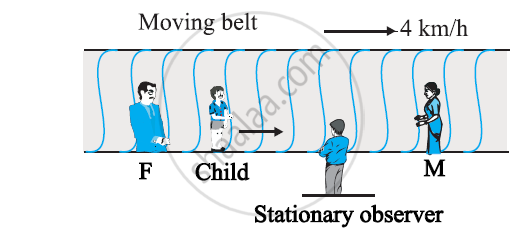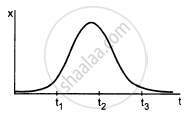Advertisements
Advertisements
Question
The accelerations of a particle as seen from two frames S1 and S2 have equal magnitude 4 m/s2.
Options
The frames must be at rest with respect to each other.
The frames may be moving with respect to each other.
The acceleration of S2 with respect to S1 may either be zero of 8 m/s2.
The acceleration of S2 with respect to S1 may be anything between zero and 8 m/s2.
Solution
The acceleration of S2 with respect to S1 may be anything between zero and 8 m/s2.
Explanation:
\[\vec{a}_{\text{ s}_2 \text{ s } _1} = \vec{a}_{\text{s }_2 \text{ p } } + \vec{a}_{\text{p} \text{s}_1} \]
\[\left| \vec{a}_{\text{ s } _2 \text{ s } _1} \right| = \sqrt{4^2 + 4^2 + 32\cos\left( \theta \right)}\]
\[- 1 < \cos\left( \theta \right) < 1\]
APPEARS IN
RELATED QUESTIONS
Read the statement below carefully and state, with reason and example, if it is true or false:
A particle in one-dimensional motion with constant speed must have zero acceleration.
The given figure gives a speed-time graph of a particle in motion along a constant direction. Three equal intervals of time are shown. In which interval is the average acceleration greatest in magnitude? In which interval is the average speed greatest? Choosing the positive direction as the constant direction of motion, give the signs of v and a in the three intervals. What are the accelerations at the points A, B, C and D?

On a long horizontally moving belt (Fig. 3.26), a child runs to and fro with a speed 9 km h–1 (with respect to the belt) between his father and mother located 50 m apart on the moving belt. The belt moves with a speed of 4 km h–1. For an observer on a stationary platform outside, what is the
(a) speed of the child running in the direction of motion of the belt ?.
(b) speed of the child running opposite to the direction of motion of the belt ?
(c) time taken by the child in (a) and (b) ?
Which of the answers alter if motion is viewed by one of the parents?

If a particle is accelerating, it is either speeding up or speeding down. Do you agree with this statement?
Give example where the velocity of a particle is zero but its acceleration is not zero.
Give example where the velocity is opposite in direction to the acceleration.
Give example where the velocity is perpendicular to the acceleration.
In figure shows the x coordinate of a particle as a function of time. Find the sings of vx and ax at t = t1, t = t2 and t = t3.

A stone is released from an elevator going up with an acceleration a. The acceleration of the stone after the release is
An object having a velocity 4.0 m/s is accelerated at the rate of 1.2 m/s2 for 5.0 s. Find the distance travelled during the period of acceleration.
The displacement of particle is given by x = `2/lambda (1 - e^(-lambdat))`, the acceleration of particle at 2s when λ = 2s–1 will be (Take `l`n 0.018 = – 4)
If the velocity of a car is given by V = (150 − 10x)½ m/s. If a car retards their motion by applying brakes then what will be the acceleration?
An object falling through a fluid is observed to have acceleration given by a = g – bv where g = gravitational acceleration and b is constant. After a long time of release, it is observed to fall with constant speed. What must be the value of constant speed?
